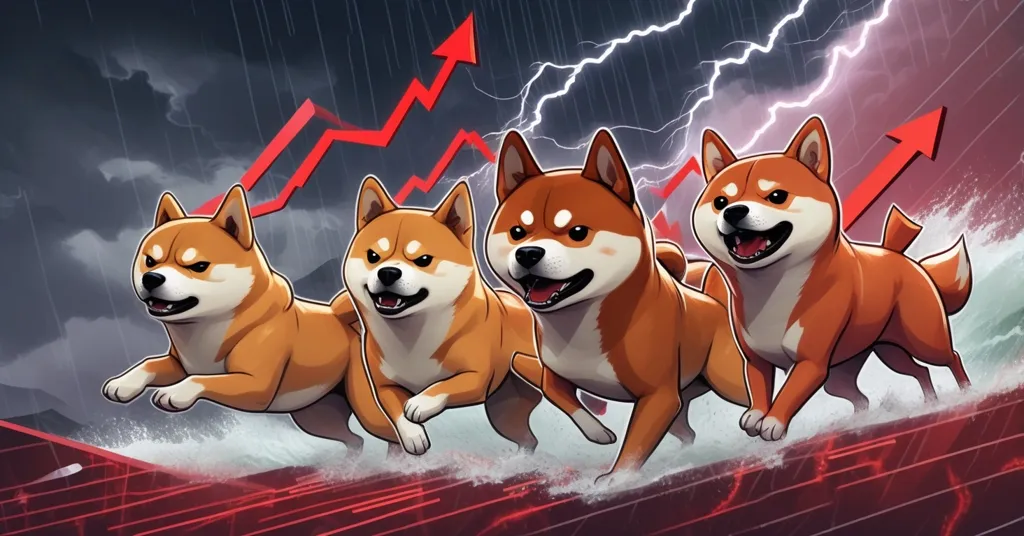Crypto Slump: Ethereum Below $4K, Shiba Inu Fades, Bitcoin Stalls at $115K

Crypto Market Turbulence: Ethereum’s $4,000 Struggle, Shiba Inu’s Fade, and Bitcoin’s $115,000 Wall
The crypto market is hitting a rough patch, with Ethereum teetering below $4,000, Shiba Inu sliding toward irrelevance, and Bitcoin unable to punch through $115,000. These bearish signals are impossible to ignore, but are they just temporary setbacks or signs of deeper cracks in the foundation? Let’s break down the technicals, market sentiment, and potential turning points with a clear-eyed view for both newbies and seasoned traders.
- Ethereum (ETH): Hovering near $4,000, showing bearish patterns with downside risks to $3,600.
- Shiba Inu (SHIB): At $0.0000102, risking a drop to $0.000008 without fresh hype or volume.
- Bitcoin (BTC): Stalled at $115,000 resistance, lacking new capital to break through.
Ethereum’s Bearish Warning Signs
Ethereum, the backbone of decentralized finance (DeFi) and smart contracts, is flashing red alerts for even the most optimistic bulls. After a rejection near $4,200, its price is barely holding above $4,000, and the daily chart reveals a troubling double top pattern. For those new to the game, a double top is like a boxer throwing two hard punches at the same wall and getting knocked back both times—it signals buyer exhaustion and often precedes a drop. The two peaks, one from mid-October and another recent failed rally, suggest sellers are gaining ground.
Technical indicators aren’t helping Ethereum’s case. The Relative Strength Index (RSI), a gauge of price momentum, sits at 47, showing neither strong buying nor selling but leaning toward weakness. Meanwhile, key trend lines called Exponential Moving Averages (EMAs)—which smooth out price data over time to highlight direction—are acting as barriers. The 50-day and 100-day EMAs loom above the current price as resistance, while the 200-day EMA at $3,600 marks a critical support level. If Ethereum slips below the $3,950-$4,000 zone, we could see a tumble to $3,800 or even $3,600, rattling altcoins that often follow its lead.
But let’s not write Ethereum off yet. As a platform powering thousands of decentralized apps (dApps) and innovations like non-fungible tokens (NFTs), its long-term value isn’t just in price charts. Upcoming upgrades, potentially around scalability through sharding, could reignite interest. Even now, on-chain data shows steady staking activity for Ethereum 2.0, hinting at committed holders. Still, short-term pain is real, and without a major catalyst, the bears might dominate for a while.
Shiba Inu: Fading Hype and Brutal Technicals
Shiba Inu, the meme token that once surfed a tidal wave of retail excitement, now looks like last week’s viral video—forgotten and fading fast. Trading at a pitiful $0.0000102, SHIB is barely clinging to a thin ascending support line, a faint hope that prices might stabilize. But if the $0.0000095 support level breaks, a slide to $0.000008 is on the cards, effectively adding another zero to its already tiny valuation. That’s not just a dip; it’s a death spiral for investor confidence. For more on these dire market predictions for Shiba Inu and Ethereum, the data paints a grim picture.
The charts are merciless. SHIB is trapped below the 50-, 100-, and 200-day EMAs, all acting as heavy resistance—think of these as ceilings the price can’t break through. The RSI at 40 suggests mildly oversold conditions, but there’s no army of buyers stepping in. Since peaking at $0.000015 in early September, a pattern of lower highs screams seller dominance. What’s worse, there’s no speculative volume or fresh capital inflows, the lifeblood of meme coins driven by community hype rather than real utility. Without a viral moment or TikTok-fueled frenzy, Shiba Inu’s silence is deafening.
Let’s give credit where it’s due, though. Meme tokens like SHIB have a cultural role, often onboarding curious newcomers to crypto with their low entry cost and playful branding. They’ve sparked conversations about decentralization in unexpected corners. But as a financial bet? The lack of developer traction, stalled metaverse promises, and competition from Dogecoin make SHIB a risky gamble. Even token burns—efforts to reduce supply and boost value—haven’t moved the needle. If you’re holding, brace for impact.
Bitcoin’s Stalemate: No Fuel at $115,000
Bitcoin, the undisputed king of crypto, is stuck in a frustrating rut. For the past week, it’s been trapped between $112,000 and $115,000, unable to breach that upper resistance wall. On-chain data from platforms like Glassnode reveals a stark reality: new capital inflows are drying up. Without fresh money flooding exchanges, there’s not enough liquidity to overpower the sell orders clustered at $115,000. Trading volume is lethargic, and the RSI shows pure indecision—neither overbought nor oversold, just a market shrugging its shoulders.
Technically, the picture isn’t rosy. The 50- and 100-day Moving Averages (MAs) are pressing down as resistance, while the 200-day MA at $108,000 offers a key support level if things go south. Should Bitcoin fail to crack $115,000 soon, a retreat to $110,000 or even $108,000 could trigger broader panic selling. This stagnation isn’t just Bitcoin’s problem—it drags down correlated assets like Ethereum, amplifying market-wide caution.
Yet, Bitcoin’s fundamentals remain rock-solid. As a store of value and hedge against centralized financial systems, its role in the fight for freedom and privacy is unmatched. Even in this lull, whale activity—large holder transactions—shows some accumulation at lower levels, per CryptoQuant data. Potential catalysts like spot ETF approvals or macroeconomic shifts could spark a rally. For now, though, the king is conserving energy, and patience is the name of the game.
Macro Shadows and Centralized Pressures
Zooming out, the broader crypto market is caught in a storm of apathy and external pressures. Low trading volumes across Ethereum, Shiba Inu, and Bitcoin signal fading enthusiasm, a sharp contrast to past bull frenzies. Macroeconomic headwinds are a big culprit. Rising interest rates and persistent inflation concerns—evident in recent CPI reports—make risky assets like crypto less appealing to institutional players. Regulatory murmurs add to the chill, with agencies like the SEC tightening scrutiny on token classifications and exchange operations. These centralized forces are a direct threat to the decentralized ethos we champion, pushing prices down as investors hedge their bets.
Bitcoin, often a bellwether for the space, feels this weight most acutely, with liquidation clusters at key levels amplifying volatility risks. Ethereum suffers indirectly as DeFi projects face funding doubts, while Shiba Inu’s retail base gets spooked by headlines. Yet, these pressures also highlight why decentralization matters—crypto’s promise is to bypass these very systems. Market dips driven by centralized overreach only underscore the need for resilient, permissionless networks.
What’s Next for Crypto?
Despite the gloom, there’s light on the horizon if you squint hard enough. For Ethereum, upcoming network upgrades focused on scalability could restore confidence, while growing DeFi and NFT adoption remind us of its unmatched utility. Bitcoin’s next halving, though potentially years away, historically tightens supply and drives interest—pair that with potential ETF breakthroughs, and the $115,000 wall might crumble. Even Shiba Inu could catch a second wind if its community ignites another viral campaign or if token burns gain traction.
Other ecosystems offer context too. Solana and Polkadot, for instance, are holding steadier with developer activity, suggesting Ethereum’s struggles aren’t universal among smart contract platforms. Short-term pain might even align with effective accelerationism (e/acc)—market corrections weed out weak projects, speeding us toward a truly decentralized financial future. The question is whether you’re betting on near-term recovery or playing the long game of disruption.
Key Questions and Takeaways
- Why is Ethereum struggling to hold $4,000?
A bearish double top pattern, rejection at $4,200, and weak momentum with an RSI of 47 point to seller control, risking a drop to $3,600 if support fails. - What’s pushing Shiba Inu toward another zero in its price?
Trading at $0.0000102 with no speculative volume, SHIB is below key EMAs and risks falling to $0.000008 if $0.0000095 support breaks. - Why can’t Bitcoin break through $115,000 resistance?
Declining capital inflows, low trading volume, and market indecision are stalling progress, with potential drops to $110,000 or $108,000 looming. - How are macro factors impacting the crypto market?
Rising interest rates, inflation fears, and regulatory scrutiny are curbing enthusiasm, pressuring prices across Bitcoin, Ethereum, and Shiba Inu. - Could these dips signal a buying opportunity?
Possibly—Ethereum’s DeFi strength, Bitcoin’s store-of-value role, and even SHIB’s cultural pull could rebound with catalysts like upgrades or community hype. - What’s the long-term outlook amidst this turbulence?
Short-term pain reinforces the need for decentralization, accelerating the shift away from centralized systems toward privacy and financial freedom.
Let’s keep it real: the wild price predictions and so-called “expert” trade analysis flooding social media are mostly hot air, often just shilling dressed up as insight. We’re not here to peddle that garbage. The data—charts, on-chain metrics, volume trends—paints a sobering picture right now. Ethereum’s technical weakness is a gut check for altcoin bulls. Shiba Inu’s fade-out is a harsh lesson in hype’s shelf life. Bitcoin’s stall reminds us even giants can stumble without momentum. But as believers in decentralization, privacy, and upending the status quo, we see these struggles as growing pains. Corrections aren’t just setbacks; they’re purges, clearing space for real innovation. Whether you’re a fresh-faced investor watching SHIB tank or an OG hodling BTC through thick and thin, the mission remains—build a financial system that answers to no one. Stay sharp, question everything, and remember: revolutions aren’t won in a day.



